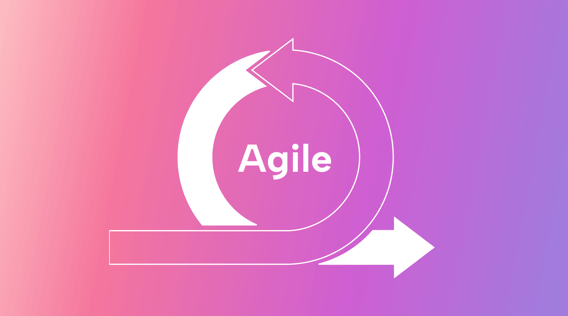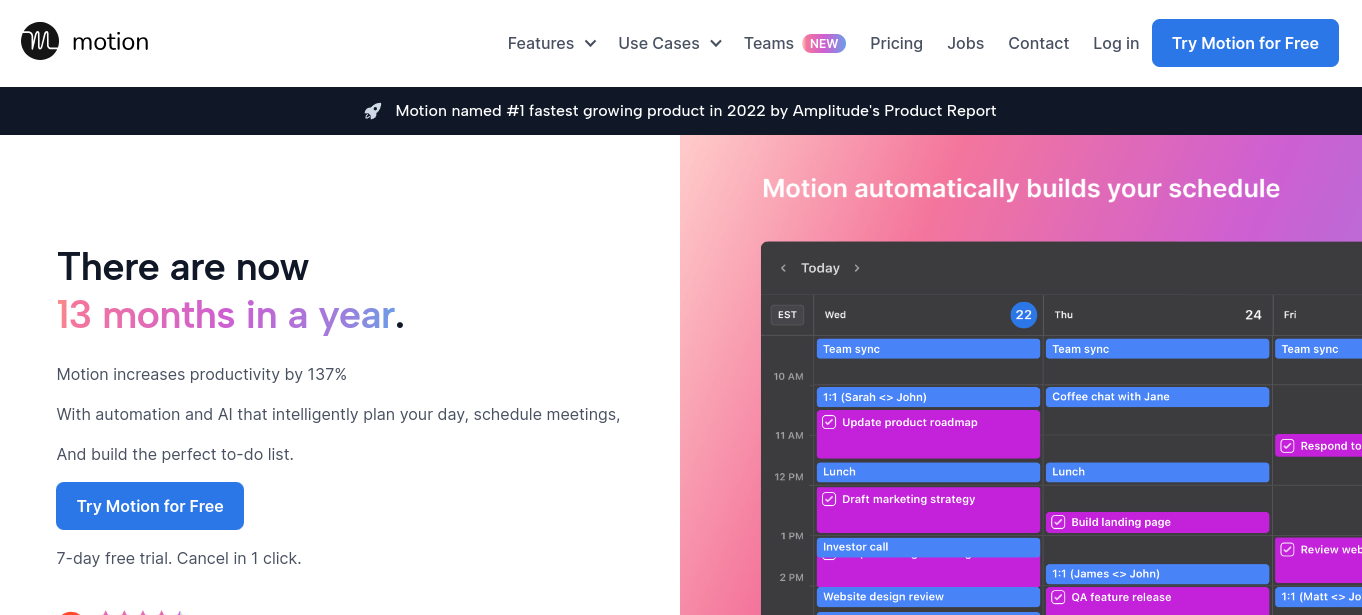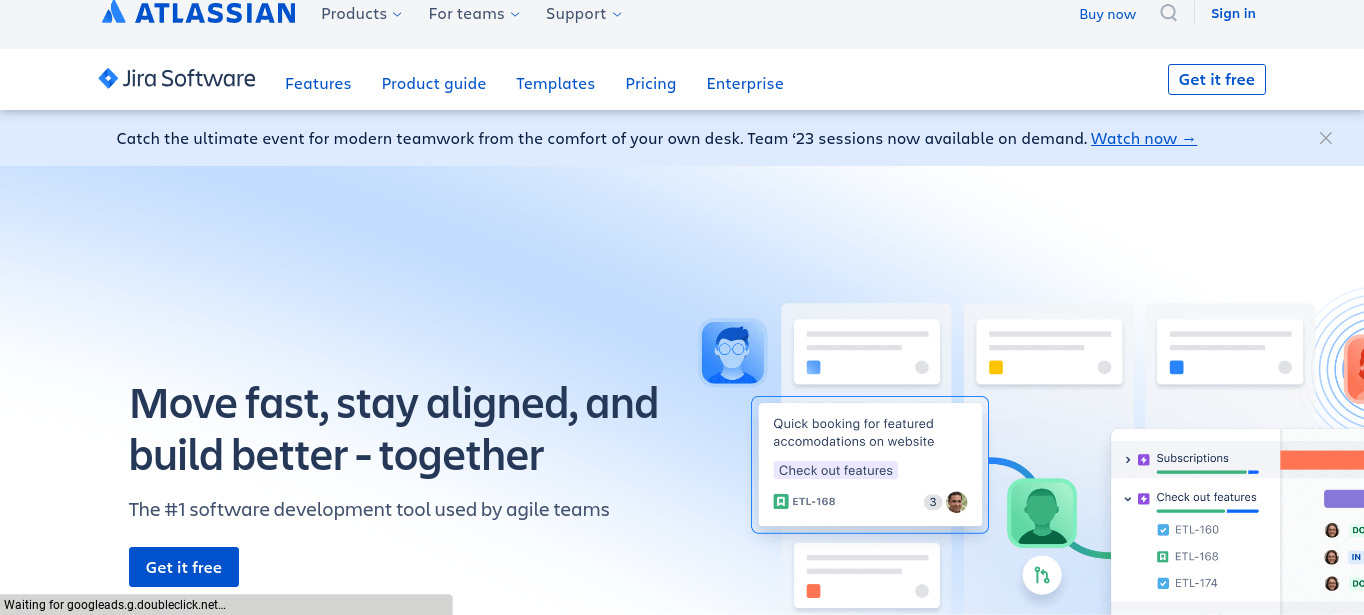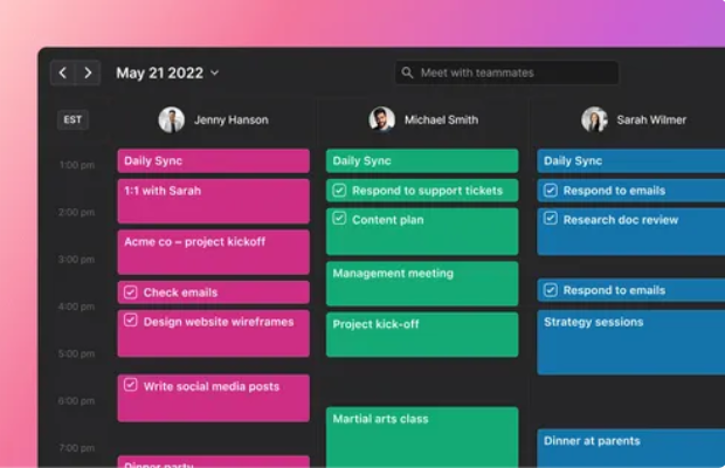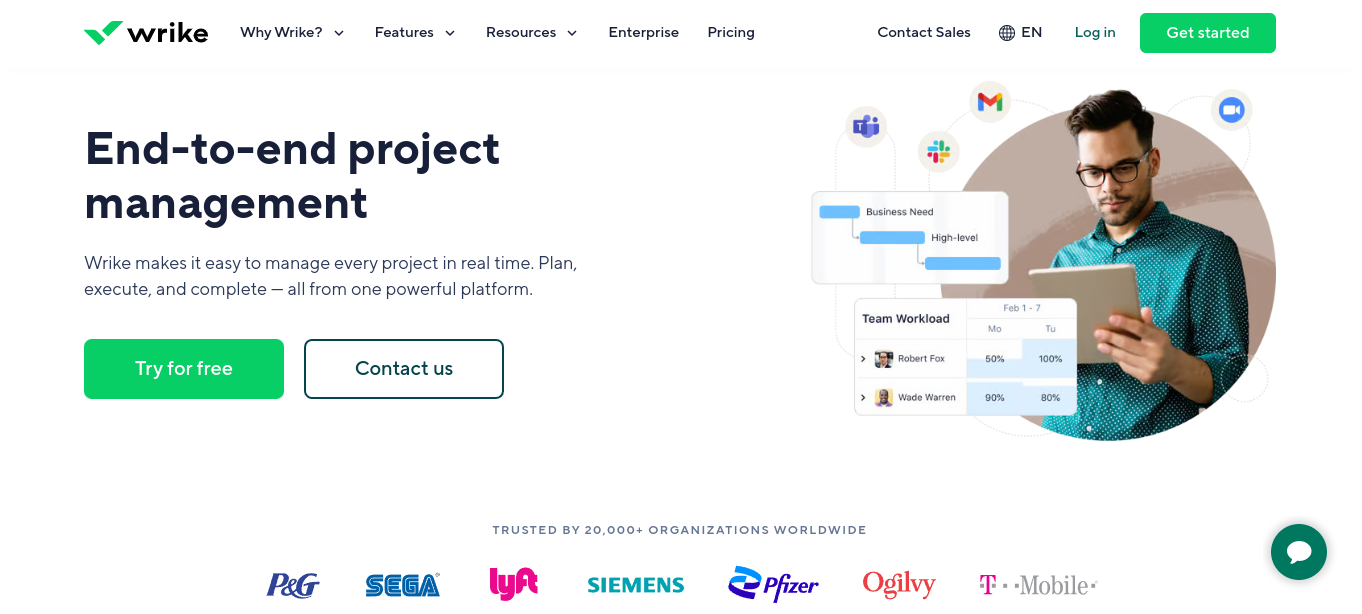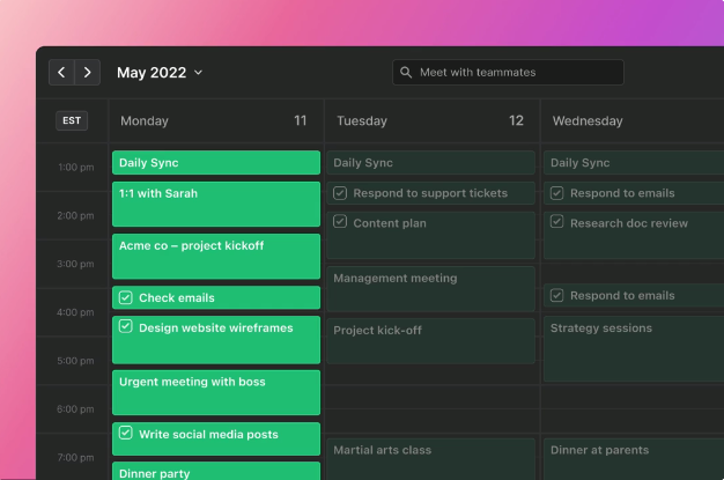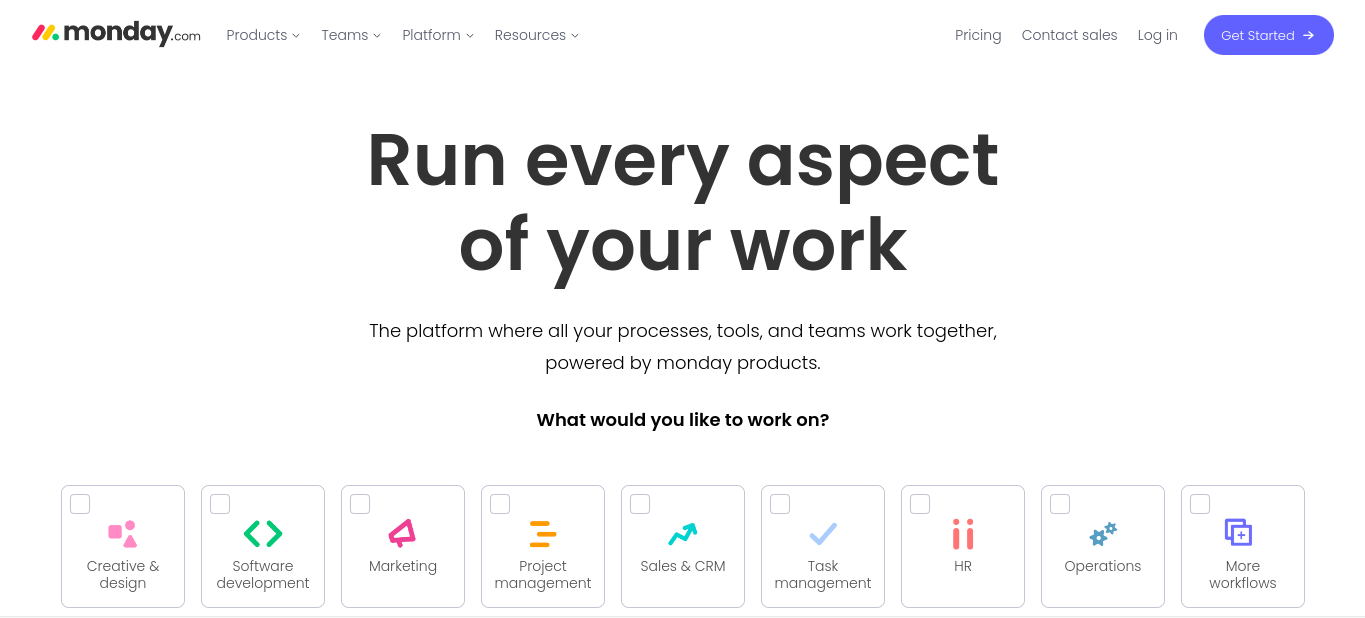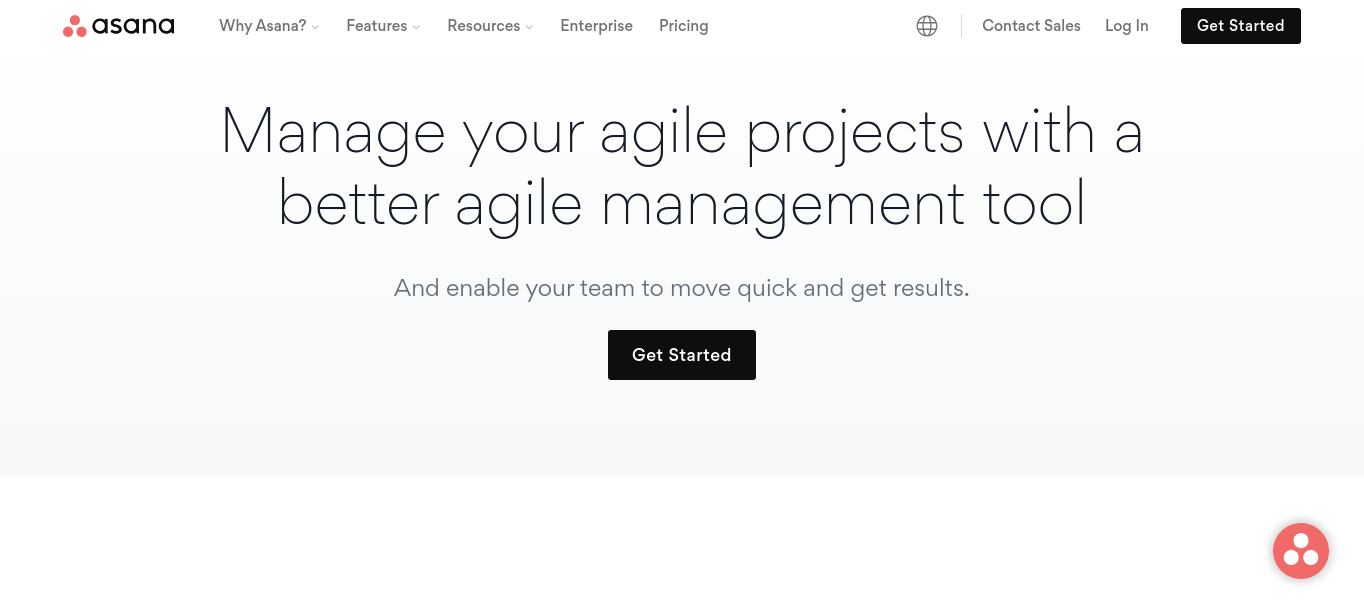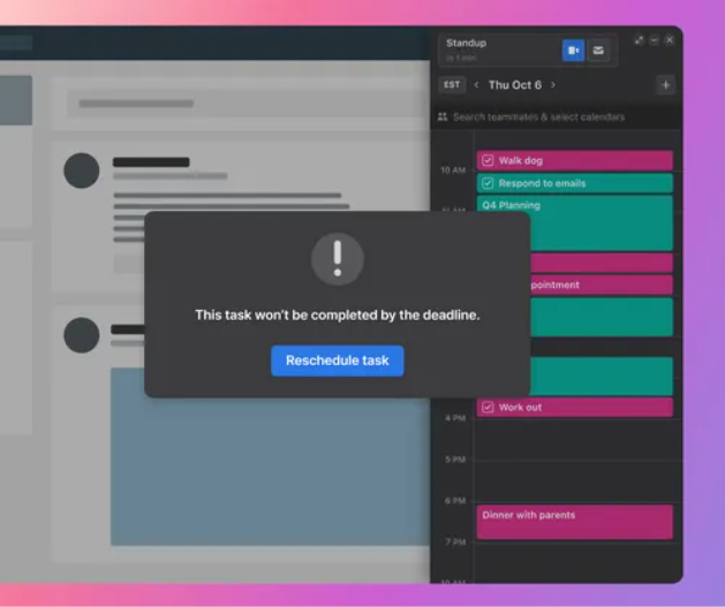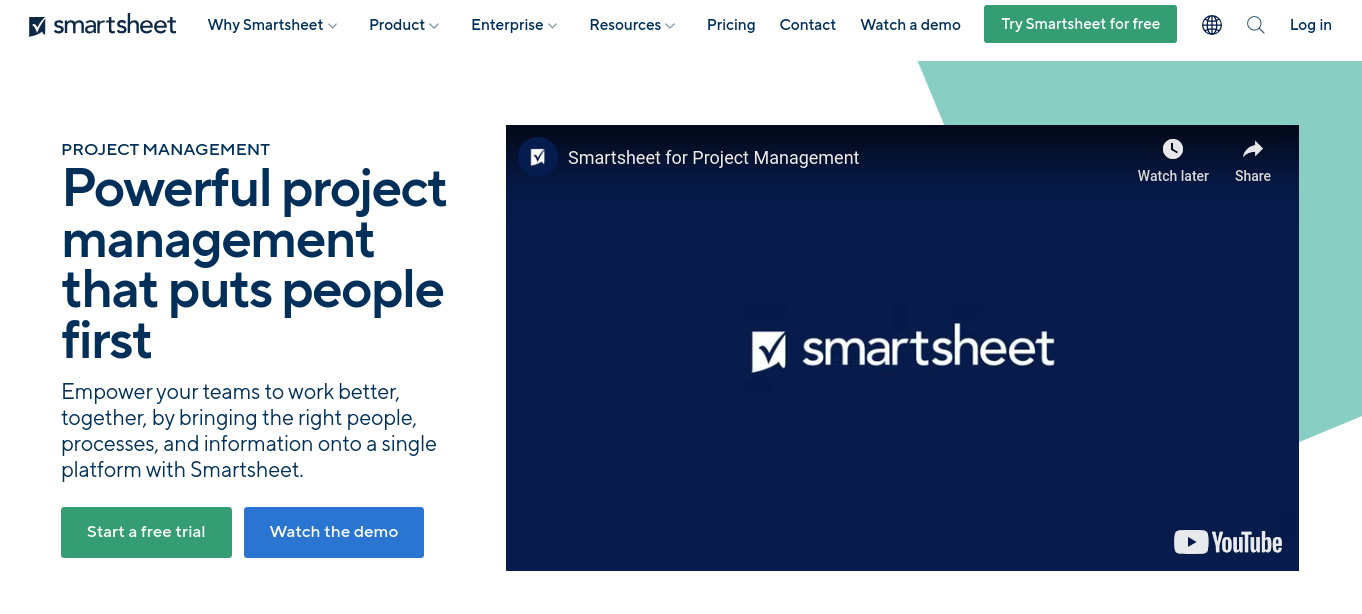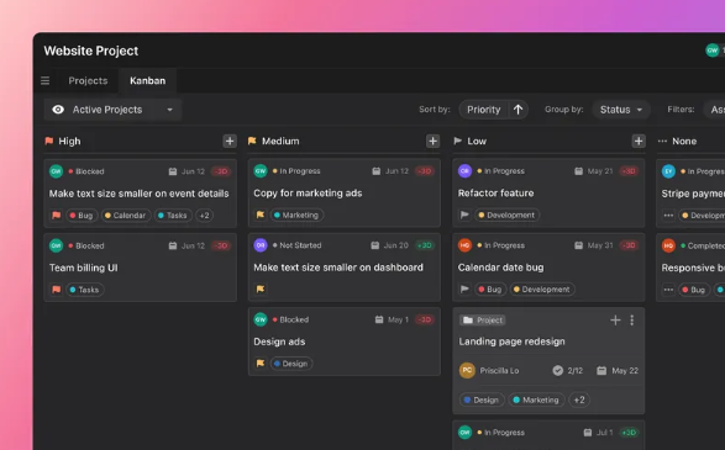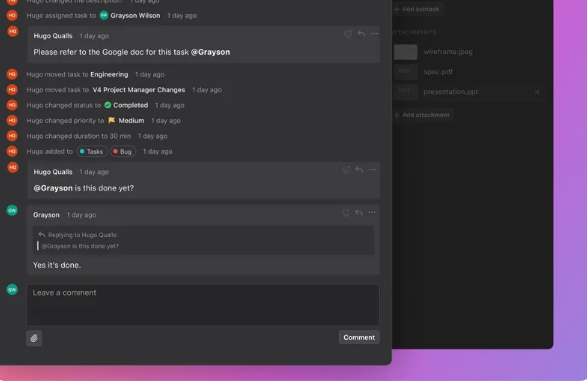The right Agile project management software keeps your team on task, on schedule, and in seamless contact with each other during a project.
But the wrong tools will leave your team confused, roadblocked, lost, and delayed.
With so many options on the market, how do you choose the right one for your team?
We’ve narrowed your search to the top six options available. We’ll review what each one offers and what to look for and consider when choosing an Agile project management tool.
Let’s get started!
Which software is used in Agile project management?
Motion
Motion optimizes every ounce of your team’s time. It uses AI and automation to streamline planning, scheduling, workflows, and monitoring.
Read more about how Motion sizes up against competitors in our blog post, Why You Should Stop Using Traditional Project Management Tools like Monday, Asana, ClickUp, Trello, and Smartsheet.
Features:
- Intelligent calendar
- Kanban and List project views
- Notes, comments, and file attachments to tasks and projects
- Workspaces
- Project templates
- Automated meeting scheduler
- Team time tracking
- API and integrations with Google tools, Microsoft tools, Zapier, and Zoom
Pros:
- Automation of scheduling/rescheduling, task assignment/reassignment, prioritization, and notifications
- Unlimited automation in all plans
- Easy setup and intuitive interface
- Tracking of time spent in meetings vs. on tasks
- Straightforward pricing
Cons:
- No native customer collaboration or review features
- Shorter free trial period
- No free plan
Pricing:
- Individual — $19/month, billed annually
- Team — $12 per user per month, billed annually
- 7-day free trial
- Calculate your monthly ROI on our pricing page
Jira Software
Jira Software is the top tool used by teams that follow the Agile methodology. This is particularly true of software development teams.
Features:
- Kanban and Scrum boards
- Drag-and-drop automation templates
- Product backlogs
- 3,000+ integrations
- Dozens of pre-built templates
- Customizable workflows
- Dashboards and Agile reports
- Timeline view and advanced product roadmaps
Pros:
- Unlimited project boards in the free plan
- Robust Agile reports, including reports for Scrum teams
- Comprehensive Agile project management capabilities
Cons:
- Automation limitations
- Steep learning curve for the non-tech-savvy
- Overwhelming interface
Pricing:
- Free plan for up to 10 users
- Standard — starts at $7.75 per user per month for the first 100 users. Annual billing priced by user tier, starting at $790/year for the first ten users.
- Premium — starts at $15.25 per user per month for the first 100 users. Annual billing priced by user tier, starting at $1,525/year for the first ten users.
- Enterprise — priced by user tier, starting at $134,500 for 801-1,000 users, billed annually. For teams of over 801 users.
- 7-day free trial version of the Standard or Premium plans — no credit card required
Motion vs. Jira
Jira Software supports Agile projects of all types. However, it was designed for software development projects. Less technical users struggle to learn and navigate it.
Motion is a simpler, more straightforward solution with a clean interface. It supports Agile teams of all sizes and industries, not just software teams. It also automates without limits on all plans, unlike Jira.
Motion creates a balanced daily schedule of prioritized tasks for each team member. It automatically reconfigures schedules to accommodate changes, disruptions, and productivity dips. It keeps the work going, due dates intact, and workloads balanced.
Motion has a per-user team rate that includes access to all features. Jira requires plan upgrades and giant price leaps as team size and the need for advanced features increase.
Wrike
Wrike is an all-in-one project management platform that best suits larger teams with more complex projects.
Features:
- Kanban boards
- Different project views
- 400+ integrations and Open API
- Gantt charts
- Automation Engine
- Customizable workspaces
- Work Intelligence
- Real-time reports, marketing insights, and advanced analytics
- Personal and team dashboards
Pros:
- Robust, feature-rich Team plan
- Powerful Gantt chart features
- Notable Agile project management capabilities
- Tons of templates, including an Agile-specific workflow template
Cons:
- Automation limits
- Difficult to learn
- Pricey for larger teams
Pricing:
- Free plan
- Team — $9.80 per user per month
- Business — $24.80 per user per month
- Contact for Enterprise and Pinnacle pricing
- Annual billing only
- Premium add-on features for an additional fee
- 14-day free trial version of any paid plan — no credit card required
Motion vs. Wrike
Like Jira, Wrike has a steep learning curve for new users and sets automation limits. You’ll also experience a considerable price jump once you reach 26 users.
Like Motion, Wrike’s Work Intelligence uses AI to automatically create daily task lists and prioritize tasks. It even generates subtasks.
But these features are only available to free or Business plan users, while Team users lack access.
And while Wrike’s AI may create and manage to-do lists, it doesn’t create scheduled, actionable plans like Motion does. Motion ensures you know what needs to be done and helps it gets done and on schedule.
Read more about how Motion eliminates to-do lists in our blog post, The To-Do List Is Dead. There’s a Better Way to Plan Your Day (And It Can Triple Your Productivity)
monday.com
monday.com is a highly flexible work management platform for teams of all sizes.
Features:
- Over ten different project views, including Kanban and Gantt
- Real-time dashboards and reporting tools
- Team collaboration features, including co-editing, comment sharing, and a collaborative whiteboard platform
- Custom workflows
- 200+ pre-built templates for customizable automation
- 40+ popular integrations
Pros:
- Powerful automation features
- Real-time team collaboration features
- Tons of templates
- Unlimited projects, tasks, users, project boards, docs, messages, and viewers
Cons:
- Automation limits and integration limits
- Challenging to learn and set up
- Most effective features in the Standard plan or higher
Pricing:
- Free plan for up to two users
- Basic — $8 per user per month, billed annually
- Standard — $10 per user per month, billed annually
- Pro — $16 per user per month, billed annually
- Contact for Enterprise pricing or pricing for teams of over 40 people on any plan
- 14-day free trial version of the Pro plan — no credit card required
Motion vs. monday.com
Of all monday.com’s plans, the Standard plan is most comparable to Motion’s team plan. It’s also their most popular plan. It’s loaded with valuable features for Agile teams and includes unlimited users.
However, it also sets monthly limits on automation and integration actions. Motion doesn’t impose such limits. You also can’t access time tracking on tasks or workload balancing unless you have the Pro plan. But Motion includes these features on all plans.
monday.com helps create and manage Agile sprints. But Motion’s AI-driven work calendar and daily planner balance the workload within sprints. They optimize time and increase productivity without burnout.
Asana
Asana is a top work management tool for multi-team businesses and cross-functional teams.
Features:
- Asana Intelligence and automation features
- Workflow Builder
- Timeline, Kanban, List, and Calendar views
- Custom templates
- 300+ integrations and API
- Team communication features
- Reporting tools
- Workload balancing
Pros:
- Robust free plan that includes unlimited projects, tasks, messages, activity logs, and file storage
- Extensive Agile project management capabilities
- No automation limits
Cons:
- Steep learning curve
- Among the pricier options
Pricing:
- Free plan for up to 15 people, including users and view-only guests
- Premium — starts at $10.99 per user per month, billed annually
- Business — starts at $24.99 per user per month, billed annually
- Contact for Enterprise pricing
- 30-day free trial version of the Business or Premium plans — no credit card required
Motion vs. Asana
Asana’s feature-rich plans help teams create Agile projects and plan sprints. It also enables the team to receive customer feedback and conduct bug tracking.
But Asana Intelligence doesn't magically create a schedule and daily plan for both individuals and the entire team like Motion does.
It doesn't automatically distribute the workload among team members. It doesn't serve prioritized daily tasks and automatically readjusts itself as necessary. And it doesn't lend accountability for what needs doing at the moment.
Motion’s pricing is simple — one rate for individuals and one per-user rate for teams. Asana’s pricing structure, however, is less straightforward than it initially seems. Each paid plan includes subscriptions determined by “spaces” and user tier.
Smartsheet
Smartsheet is a scalable work management platform.
Features:
- Workflow automation and cross-platform process automation
- Digital asset management
- Team collaboration features
- 80+ integrations and API
- Analytics, reporting, and work insights
- WorkApps custom mobile and web app builder
- Gantt charts, Calendars, Grids, and Cards
Pros:
- Free plan with unlimited dashboards and reports and multiple project views
- Unlimited project sheets in all paid plans
Cons:
- Automation limits on non-premium plans
- Complicated if unfamiliar with spreadsheets
Pricing:
- Free plan for one user and up to two editors
- Pro — $7 per user per month for up to 10 users, billed annually
- Business — $25 per user per month, billed annually, for a minimum of three users
- Contact for Enterprise pricing
- 30-day free trial version of the Business plan — no credit card required
Motion vs. Smartsheet
Smartsheet has a lot of features Agile teams can use for project planning and collaboration. But, like other tools on this list, it lacks the features necessary to streamline, optimize, and balance schedules to ensure work gets done on time.
Features that Motion’s fully AI-powered solution possesses.
Smartsheet can also be challenging to set up and learn unless you're experienced and comfortable with spreadsheets. Other drawbacks include automation limits and the high price for growing teams.
What should you look for in Agile project management software?
Core features
We looked at key features included with the top products on the market in the list above. Now let's review the core features every high-quality software option should have.
Integrations
Your new Agile tool should integrate well with your preexisting tools. You should be able to seamlessly plug the new tool into your existing processes and find that everything plays nicely together.
Zapier integration is also valuable as it connects virtually everything. Open API allows for building custom integrations.
Automation
Automation is critical for saving time on manual, repeatable, and mundane tasks so you can boost your team's efficiency.
When choosing an Agile tool, check which features are automated, how they are automated (customizable triggers vs. AI), and whether there are automation limits.
Communication and collaboration tools
Remote teams of all sizes need to communicate and collaborate effectively with each other and clients on projects. Even one-person businesses need an effective way of connecting remotely with clients and partners.
Top tools include reliable communication and collaboration features to facilitate this.
Management of tasks, teams, and workflows
Among key features should include tools to help create and manage a project's many work tasks, teams, and workflows.
The size and nature of your business determine the number of tasks, users, teams, projects, and project views you’ll need at your disposal.
Tracking
Tracking functions help monitor performance over time, identify issues, make adjustments, and measure the effectiveness of those adjustments. This helps Agile project managers ensure incremental progress.
Time tracking and monitoring project progress help identify unbalanced workloads to ensure everyone’s plates are full but not overflowing. Finally, tracking reveals opportunities for continuous improvement and further growth.
Selection criteria
You’ll need to determine some of the following criteria for your specific business and team. Others can be determined with insights from customer reviews, testimonials, and case studies.
Pricing:
New additions to your tech stack shouldn’t cost more money than they help make.
How much of the budget can your business allocate to purchasing a new Agile project management solution? What wiggle room do you have, if any? Only consider the tools that fall within your means.
Usability:
You don’t want too big of a learning curve. How easy is the setup? How intuitive is the interface? Can everyone on your project team learn it quickly, even if transitioning from a different tool? Can you quickly onboard new team members? Can clients use it readily?
Flexibility:
Businesses grow, evolve, and adapt. Their software needs to be able to follow them or else be replaced. Do your choices for Agile software suit your business now and have the flexibility to meet your business wherever it goes?
Project type:
The types of projects you typically undertake will help determine the software you need. In what industry is your business? Do you make sales, offer a service, or both? Do you host events? Create web or social media content? Handle marketing in-house?
Team size:
Some software accommodates specific team sizes better than others. This is due to the features offered, pricing tiers, or the number of projects allowed.
Do you run a small or medium-sized business, a large company, or an enterprise-scale corporation? How many projects does your business juggle at once? Are they complex projects?
Agile framework requirements:
The two most common Agile approaches are Scrum and Kanban. Others include Extreme Programming (XP), Feature-driven Development (FDD), Dynamic Systems Development Method (DSDM), and Crystal.
Do your Agile project management tool options support your business’ preferred Agile framework?
Choose Motion as your go-to Agile project management software
Now that you know what to look for and consider, you’re ready to test drive your top options.
Have we convinced you of Motion’s seamlessness, flexibility, intuitiveness, intelligence, and affordability?
Ready to try it for yourself?
Sign up today for a 7-day free trial to see what Motion offers. Experience growth in productivity and output, and regain a surplus of spare time with Motion.

